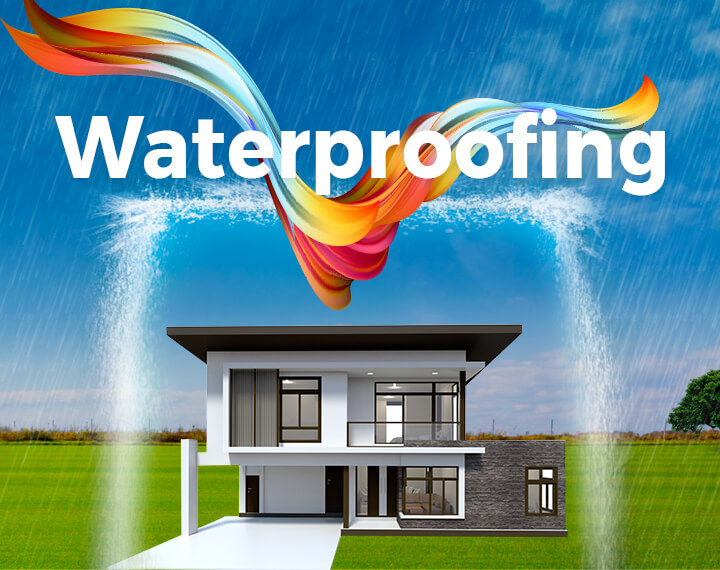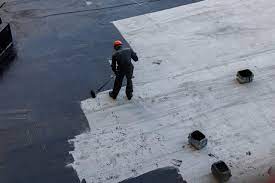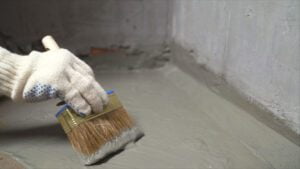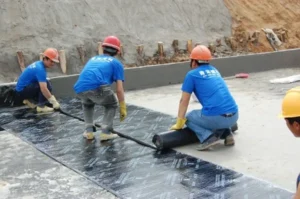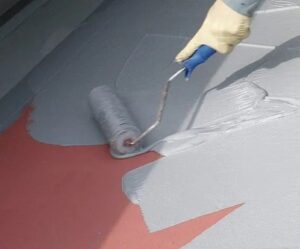10 Benefits Waterproofing of Your Home
- waterproofing your home is crucial for several reasons, as it helps protect the structure, occupants, and belongings from the damaging effects of water infiltration.
- Here are some key reasons highlighting the importance of waterproofing for your home:
Prevention of Structural Damage:
-
- Water can cause significant structural damage over time. It can weaken the foundation, erode concrete, rust steel, and lead to the deterioration of various building materials. Waterproofing helps prevent these issues and ensures the long-term stability of the structure.
- Repairing structural damage promptly is crucial for the prevention of further deterioration and to maintain the integrity of the building.
- Regular inspections and timely interventions can help in identifying potential threats early, thus avoiding costly repairs and ensuring the longevity of the structure.
Mold and Mildew Prevention:
-
- Excessive moisture can create an environment conducive to the growth of mold and mildew. These microorganisms not only compromise indoor air quality but can also pose health risks, especially for individuals with respiratory conditions.
Preservation of Interior Finishes:
-
- Water damage can ruin interior finishes such as drywall, paint, and flooring. Waterproofing measures protect these finishes, preserving the aesthetic appeal of your home and reducing the need for frequent repairs and renovations.

Protection of Belongings:
-
- Water damage can destroy personal belongings, furniture, and electronic devices. Waterproofing safeguards your possessions from potential water-related disasters, minimizing financial losses and the emotional impact of losing cherished items.
Prevention of Electrical Issues:
-
- Water infiltration can pose a serious threat to electrical systems within a home. Waterproofing helps prevent electrical issues, reducing the risk of electrical fires and ensuring the safety of the occupants.
Energy Efficiency:
-
- Proper insulation and waterproofing contribute to the overall energy efficiency of a home. By preventing water infiltration and maintaining a dry environment, the home is better equipped to retain heat in winter and stay cool in summer, reducing the need for excessive heating or cooling.
Improved Indoor Air Quality:
-
- Water damage can lead to the growth of mold and mildew, contributing to poor indoor air quality. Waterproofing measures help maintain a dry and healthy living environment, reducing the risk of respiratory issues and allergies.
Increased Property Value:
-
- A well-maintained and waterproofed home is more likely to retain its value over time. Potential buyers are often attracted to homes that have undergone preventive measures, as it signals responsible homeownership and reduces the likelihood of hidden water-related issues.
Mitigation of Potential Legal Issues:
-
- In some cases, water damage can lead to legal issues, especially if it affects neighboring properties. By waterproofing your home, you mitigate the risk of disputes with neighbors and potential legal liabilities.
Long-Term Cost Savings:
-
- While investing in waterproofing may incur upfront costs, it can result in long-term savings by preventing expensive repairs and the need for extensive renovations due to water damage.
How to do Effective waterproofing of Your Home
- Effective waterproofing is crucial for homes, especially during the rainy season, to prevent water damage and maintain the structural integrity of the building. You can refer four steps as per procedure on the type of water proof packing.
- Here are some best waterproofing techniques for homes:
Roof Waterproofing:
-
- High-Quality Roofing Materials:
- Invest in high-quality roofing materials that have good waterproofing properties.
- Ensure that the roof is properly installed and well-maintained.
- Proper Sloping:
- Ensure that the roof has a proper slope to facilitate water drainage.
- Standing water on the roof can lead to leaks over time.
- High-Quality Roofing Materials:

Gutters and Downspouts:
-
- Clean and Maintain Gutters:
- Regularly clean and maintain gutters to prevent clogs.
- Clogged gutters can lead to water overflow, causing damage to the roof, walls, and foundation.
- Downspout Extensions:
- Use downspout extensions to direct rainwater away from the foundation and prevent water accumulation around the structure.
- Clean and Maintain Gutters:
Exterior Wall Waterproofing:
-
- Sealant Application: Apply waterproof sealants or coatings to exterior walls. This helps create a protective barrier against water penetration.
- Correcting Wall Cracks: Fill and seal any cracks in the exterior walls promptly. Even small cracks can allow water to seep in over time.
- Foundation Waterproofing:
- Waterproofing Membranes: Apply waterproofing membranes to the foundation walls to prevent water penetration. This is especially important in areas with high groundwater levels.
- French Drains: Install French drains or other drainage systems around the foundation to redirect water away from the building.
- Window and Door Seals:
- Weather Stripping: Install weather stripping around windows and doors to prevent water infiltration. Check and replace weather stripping as needed.
- Proper Installation: Ensure that windows and doors are properly installed, and that any gaps or openings are sealed effectively.
- Balcony and Terrace Waterproofing:
- Waterproofing Membranes: Apply waterproofing membranes or coatings to balconies and terraces to protect against water damage.
- Regular Inspection: Regularly inspect the sealant and grout around tiles on balconies and terraces. Repair or replace any damaged areas promptly.
Basement Waterproofing:
-
- Interior Sealants: Apply waterproof sealants or coatings to the interior walls of basements to prevent moisture penetration.
- Sump Pump Installation: In areas prone to flooding, consider installing a sump pump in the basement to remove excess water.

- Landscaping:
- Proper Grading: Ensure that the landscape around the house is properly graded to direct water away from the foundation.
- Use of Plants and Mulch: Use plants and mulch to prevent soil erosion, which can contribute to water runoff.
- Regular Inspections:
- Routine Maintenance: Conduct regular inspections of the roof, walls, foundation, and other vulnerable areas. Address any issues promptly to prevent further damage.
- Professional Inspection: Consider hiring professionals for a thorough inspection and to identify potential waterproofing issues.

Which is the best waterproof for a Normal Home
- Waterproofing for a home is crucial to prevent water damage and maintain the structural integrity of the building.
- The best suitable time to do waterproofing is at the time of construction of your home.
- Waterproofing new construction comprises a high-quality liquid waterproofing mixed with cement, and sand.
- Here are some common and effective waterproofing measures for a normal home:
- Roof Waterproofing:
- Ensure your roof is in good condition, repairing any damaged shingles or tiles.
- Apply a waterproof coating on the roof surface.
- Install a high-quality waterproof membrane under the roofing material.
- Exterior Wall Waterproofing:
- Seal any cracks in the exterior walls using waterproof sealants.
- Apply a waterproof coating or membrane to the exterior walls.
- Install proper drainage systems to direct water away from the foundation.
- Foundation Waterproofing:
- Use waterproofing paints or coatings on the foundation walls.
- Install a drainage system, such as French drains, around the foundation.
- Ensure proper grading around the foundation to direct water away.
- Basement Waterproofing:
- Seal basement walls with waterproofing compounds.
- Install a sump pump to manage water accumulation in the basement.
- Consider applying a waterproof membrane on the exterior of the basement walls.
- Window and Door Seals:
- Check and replace weatherstripping around windows and doors.
- Ensure that windows and doors are properly sealed to prevent water infiltration.
- Gutter Maintenance:
- Keep gutters clean from debris to ensure proper water drainage.
- Install gutter guards to prevent clogs.
- Direct downspouts away from the foundation.
- Landscaping:
- Create proper landscaping slopes away from the house.
- Use plants and mulch to help with soil erosion control.
- Interior Waterproofing:
- Use waterproof sealants on interior walls in areas prone to moisture.
- Consider using waterproofing paints in areas like basements.
- Regular Inspections and Maintenance:
- Regularly inspect your home for any signs of water damage.
- Promptly address any leaks or water-related issues.
- Professional Assistance:
- Consult with waterproofing professionals for a comprehensive assessment and tailored solutions.
It’s essential to note that the specific waterproofing measures may vary based on the climate, soil conditions, and the construction of your home. Consulting with a local waterproofing professional can provide personalized recommendations based on your home’s unique needs.
Conclusion
- It’s important to note that a combination of these techniques is often the most effective approach.
- Additionally, consulting with waterproofing professionals and following local building codes and standards is crucial for the success of any waterproofing project.
- When selecting waterproof materials, it’s important to consider the specific application, environmental conditions, and the compatibility of the materials with other construction components.
- Additionally, proper installation by qualified professionals is crucial to ensuring the effectiveness of waterproofing measures.
